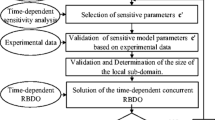This research focuses on the development of a quantitative intelligent system for implementing concurrent engineering design. The paper first discusses the task of concurrent engineering design and the basic requirements for conducting integrated concurrent engineering design. The proposed quantitative intelligent system approach combines qualitative reasoning, based upon design and manufacturing knowledge, and quantitative evaluation and optimization, conducted using design information and manufacturing data generated in the knowledge-based reasoning. The method allows considerations on non-operating principle aspects of a product to be incorporated into the design phase, such as manufacturing, maintenance, service, recycle, etc., with an emphasis on production costs. The proposed method serves as a convenient software tool for gathering information required in the concurrent engineering design process and integrates tasks from different parts of the product development life cycle, particularly function design, manufacturability analysis and production cost estimation. A prototype software system is developed based upon this method using Smalltalk-80. In the prototype system, concurrent engineering design is carried out by: (1) describing and representing design requirements; (2) generating feasible design candidates and evaluating their design functions; (3) representing design geometry; (4) finding the associated production processes and predicting the production costs of each feasible design; and (5) identifying the costeffective design that satisfies given design requirements and requires minimum production costs.
Similar content being viewed by others
References
Bobrow, D. G. (ed.) (1985) Qualitative Reasoning about Physical Systems, MIT Press.
Chang, T. C., Wysk, R. A. and Wang, H. P. (1991) Computer-Aided Manufacturing, Prentice-Hall.
de Kleer, J. (1986) An assumption-based TMS. Artificial Intelligence, 28, 127–162.
Dong, Z. (1993) Design for automated manufacturing, ch. 9 in Concurrent Engineering: Automation, Tools, and Techniques, Kusiak, A. (ed.), John Wiley & Sons, pp. 207–234.
Dong, Z. and Hu, W. (1991) Optimal process sequence identification and optimal process tolerance assignment in computer-aided process planning. Computers in Industry, 17, 19–32.
Dong, Z. and Soom, A. (1990) Automatic optimal tolerance design for related dimension chains. Manufacturing Review, 3(4), 262–271.
Goldberg, A. and Robson, D. (1983) Smalltalk-80: The Language and Its Implementation, Addison-Wesley.
Hayes-Roth, F., Wateman, D. A. and Lenat, D. B. (1983) Building Expert Systems, Addison-Wesley.
Kunz, J. C. (1984) Application development using a hybrid AI development system. AI Magazine, 5(3).
Kusiak, A. (ed.) (1993) Concurrent Engineering: Automation, Tools, and Techniques, John Wiley & Sons.
Minsky, M. (1975) A framework for representing knowledge, in The Psychology of Computer Vision, Winston, P. H. (ed.), McGraw-Hill, New York, pp. 221–277.
Ohsuga, S. (1985) Introducing knowledge processing to CAD/CAM. Finite Elements in Analysis and Design, 1, 255–269.
Robert, R. B. and Goldstein, I. P. (1977) The FRL primer, MIT AI Memo 408.
Shah, J. J. (1991) Assessment of features technology. Computer-Aided Design, 23(5), 331–343.
Stefik, M. (1983) Knowledge programming in LOOPS: report on an experimental course. AI Magazine, 4(3).
Tomiyama, T. and ten Hagen, P. J. W. (1987)The concept of intelligent integrated interactive CAD systems, CWI Report No. CS-R8717, Centre for Mathematics and Computer Science, Amsterdam, The Netherlands.
Trucks, H. E. (1976) Designing for Economical Production, H. B. Smith (ed.), Society of Manufacturing Engineers, Dearborn, MI.
Tuthill, G. S. (1990) Knowledge Engineering: Concepts and Practices for Knowledge Based Systems, TAB Professional and Reference Books.
Umeda, Y., Takeda, H., Tomiyama, T. and Yoshikawa, H. (1990) Function, behavior, and structure, in Applications of Artificial Intelligence in Engineering V, Vol. 1: Design, Gero, J. S. (ed.), Springer-Verlag, Berlin, pp. 177–193.
Veth, B. (1987) An integrated data description language for coding design knowledge, in Intelligent CAD Systems I: Theoretical and Methodological Aspects, ten Hagen, P. J. W. and Tomiyama, T. (eds), Springer-Verlag, Berlin, pp. 295–313.
Xue, D. and Dong, Z. (1993) Feature-based concurrent design incorporating tolerance and production process models. Concurrent Engineering: Research and Applications, 1(2), 107–116.
Xue, D., Takeda, H., Kiriyama, T., Tomiyama, T. and Yoshikawa, H. (1992) An intelligent integrated interactive CAD—a preliminary report, in Intelligent Computer Aided Design, Waldron, M. B., Brown, D. and Yoshikawa, H. (eds), North-Holland, Amsterdam, pp. 163–192.
Yoshikawa, H. (1981) General design theory and a CAD system, in Man-Machine Communication in CAD/CAM, Proceedings of IFIP W.G. 5.2 Working Conference 1980 (clTokyo), Sata, T. and Warman, E. A. (eds), North-Holland, Amsterdam, pp.241–253.
Zeid, I. (1991) CAD/CAM Theory and Practice, McGraw-Hill, New York.
Author information
Authors and Affiliations
Rights and permissions
About this article
Cite this article
Xue, D., Dong, Z. Developing a quantitative intelligent system for implementing concurrent engineering design. J Intell Manuf 5, 251–267 (1994). https://doi.org/10.1007/BF00123697
Issue Date:
DOI: https://doi.org/10.1007/BF00123697




